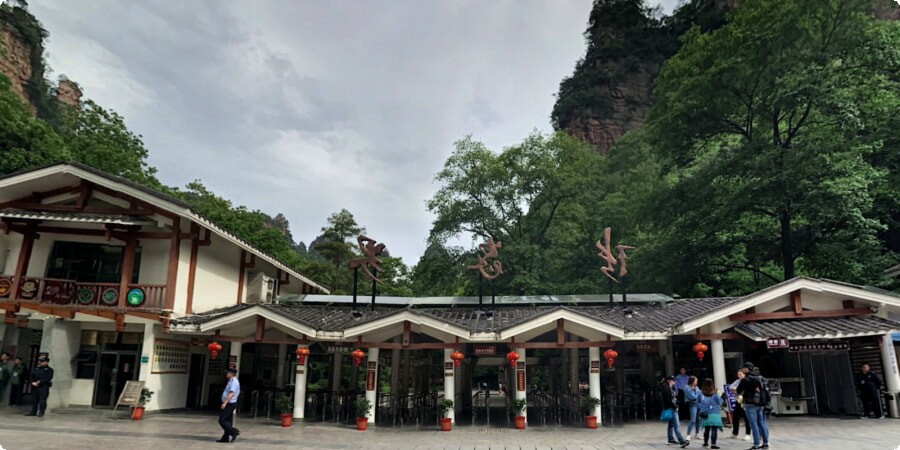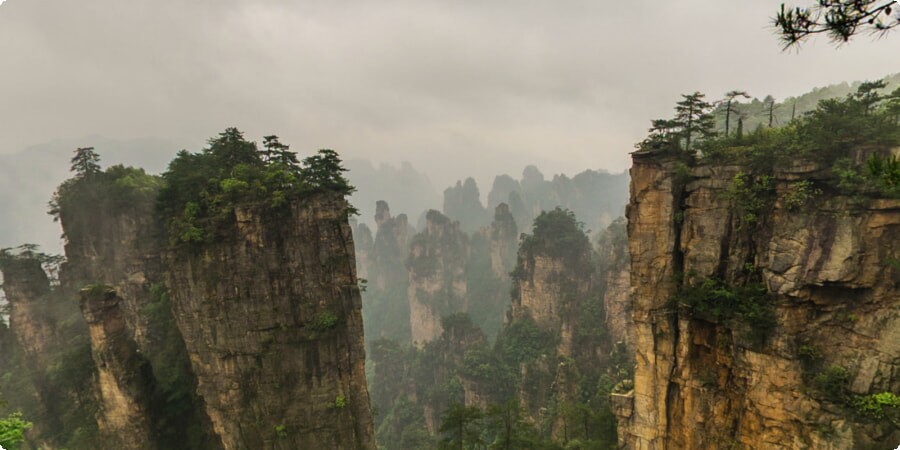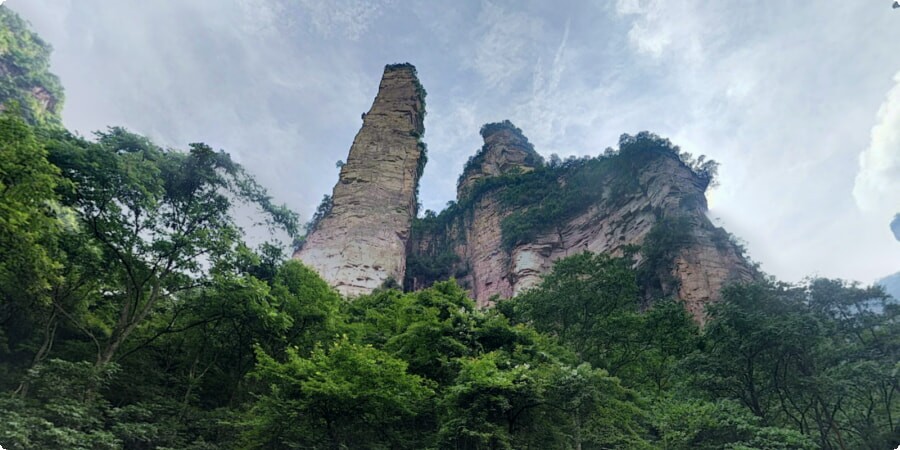Zhangjiajie National Forest Park: A Traveler’s Guide to China’s Avatar Mountains
Nestled in the heart of China’s Hunan Province, Zhangjiajie National Forest Park is a natural wonder that has captivated travelers and photographers from around the globe. This stunning park is renowned for its towering sandstone pillars, verdant forests, and mist-covered valleys, creating a landscape that feels otherworldly. It's no wonder that this mesmerizing scenery served as the inspiration for the floating Hallelujah Mountains in James Cameron’s film Avatar.
Designated as China's first national forest park in 1982, Zhangjiajie has become a UNESCO World Heritage site, drawing visitors with its unique geological formations and biodiverse ecosystem. The park spans over 11,900 acres, offering countless opportunities for exploration and adventure. Whether you're an avid hiker, a photography enthusiast, or simply someone who appreciates natural beauty, Zhangjiajie promises an unforgettable experience.
For those planning a visit, the journey to Zhangjiajie is as much about immersing oneself in the culture and history of the region as it is about marveling at its natural splendor. From ancient myths and legends to modern cinematic fame, Zhangjiajie National Forest Park is a destination that blends the past with the present in a truly unique way.
Explore Zhangjiajie National Forest Park on Google Maps.
The Unique Geography and Ecosystem of Zhangjiajie
Zhangjiajie’s landscape is characterized by its striking sandstone pillars, some of which reach up to 200 meters in height. These towering formations are the result of millions of years of erosion, sculpted by natural forces like wind and water into the dramatic peaks that we see today. This unique topography is not only breathtaking but also a rare geological phenomenon, with Zhangjiajie being one of the few places in the world where such karst landscapes are found.
The park’s ecosystem is equally impressive. Zhangjiajie is home to over 3,000 species of plants and a wide variety of wildlife, including several rare and endangered species. As you explore the park, you'll find yourself immersed in dense subtropical forests, with bamboo groves, pine trees, and vibrant wildflowers creating a rich tapestry of colors and textures. The park is also a sanctuary for various animals, such as the rhesus monkey and the elusive clouded leopard, making it a paradise for nature lovers and wildlife enthusiasts.
The diverse flora and fauna thrive in a climate that is both temperate and humid, with four distinct seasons that each offer a different perspective of the park’s beauty. From the fresh greens of spring to the vibrant reds and oranges of autumn, Zhangjiajie’s natural scenery is constantly changing, ensuring that no two visits are ever the same.
For those keen to delve deeper into the unique geography and ecosystem of Zhangjiajie, the park offers numerous guided tours and educational programs. These provide a deeper understanding of the region’s geological history and its current conservation efforts, allowing visitors to appreciate the delicate balance that sustains this incredible natural wonder.
Learn more about Zhangjiajie’s geography on Wikipedia.

Must-See Attractions Within the Park
Zhangjiajie National Forest Park is a vast landscape filled with iconic sights and hidden gems. For first-time visitors, there are a few must-see attractions that should be at the top of your list:
-
Avatar Hallelujah Mountain: This is perhaps the most famous attraction in Zhangjiajie, and for good reason. The pillar, originally known as the Southern Sky Column, was renamed after it served as the inspiration for the floating mountains in the movie Avatar. A visit here offers breathtaking views of the surrounding peaks and valleys, especially if you catch it during the early morning when the mist rolls in, creating an ethereal atmosphere.
-
Tianzi Mountain: Known as the "Monarch of the Peak Forest," Tianzi Mountain offers panoramic views of the surrounding area. The mountain is famous for its forest of towering sandstone pillars, which create a sea of green spikes that stretch as far as the eye can see. A cable car ride to the top is highly recommended, providing a bird’s-eye view of the unique landscape.
-
Golden Whip Stream: For those looking for a more tranquil experience, a walk along the Golden Whip Stream is a must. This scenic trail runs alongside a clear, meandering stream, surrounded by towering cliffs and lush vegetation. It’s a peaceful retreat from the busier parts of the park and a great spot for photography and wildlife watching.
-
Yuanjiajie Scenic Area: This area is known for its stunning viewpoints and is home to the famous First Bridge Under Heaven, a natural rock bridge that connects two mountain peaks. Yuanjiajie is also a great place to see the “Floating Mountains” from the movie Avatar. The area is accessible by a variety of paths and is well-marked, making it easy to explore.
With so many attractions to choose from, it’s worth planning your visit ahead of time to make the most of your experience. For those looking to stay nearby and explore the park over several days, consider booking a hotel in Hong Kong, which offers a range of accommodations from luxury resorts to budget-friendly options. For the best deals, check out this link.

Exploring the Glass Bridge: A Walk Above the Clouds
One of Zhangjiajie’s most thrilling attractions is the Zhangjiajie Glass Bridge, a marvel of modern engineering that spans the Grand Canyon of Zhangjiajie. Opened in 2016, this glass-bottomed bridge is the highest and longest of its kind in the world, stretching over 430 meters (1,410 feet) and hovering 300 meters (980 feet) above the canyon floor. Walking across the glass panels, which provide a dizzying view of the gorge below, is an exhilarating experience that challenges even the bravest of travelers.
The bridge is designed to blend seamlessly with the natural landscape, offering a unique vantage point to appreciate the park’s rugged beauty. On a clear day, you can see for miles across the jagged peaks and lush valleys that define Zhangjiajie’s terrain. The experience is even more thrilling during early mornings when the mist envelops the bridge, creating the sensation of walking on clouds.
For those interested in visiting the Glass Bridge, it’s advisable to purchase tickets in advance due to its popularity. Be sure to wear comfortable shoes and be prepared for a heart-pounding adventure. Remember, photography is encouraged, but drones are prohibited for safety reasons.
While the Glass Bridge is an unforgettable experience, it is just one of many attractions within the park. Visitors are encouraged to explore the surrounding trails and viewpoints to fully appreciate the breathtaking scenery that makes Zhangjiajie a world-renowned destination.
Navigating Zhangjiajie: Tips for Getting Around
Navigating Zhangjiajie National Forest Park can seem daunting due to its vast size and diverse terrain, but with a bit of planning, it’s manageable and incredibly rewarding. The park is divided into several distinct areas, each offering unique attractions and experiences. To make the most of your visit, consider the following tips:
-
Use the Park’s Shuttle Buses: The park provides an efficient shuttle bus service that connects the main entrances with key attractions. This is a great way to save time and energy, especially if you plan to visit multiple areas in one day. The buses are frequent and cover most of the park’s major sights.
-
Plan Your Route: Before setting out, it’s a good idea to map out your day based on the attractions you want to see. Prioritize sites that are close to each other to minimize travel time and maximize your exploration. Most visitors start at the Zhangjiajie National Forest Park entrance or the Wulingyuan Scenic Area entrance, depending on which attractions they wish to visit first.
-
Consider Hiring a Local Guide: If you’re short on time or want to gain deeper insights into the park’s history and natural wonders, hiring a local guide can be invaluable. Guides are available at most park entrances and can customize your tour based on your interests and physical ability.
-
Accommodation Options: For those planning to explore Zhangjiajie over several days, staying within the park or in nearby Wulingyuan is a great option. There are a variety of accommodations available, ranging from budget hostels to luxury hotels. To find the best options, consider booking a hotel in China through this link, which offers a comprehensive guide to the top-rated hotels in the region.
By following these tips, you’ll be well-prepared to navigate the park efficiently and enjoy all the natural beauty Zhangjiajie has to offer.

Seasonal Beauty: The Best Time to Visit Zhangjiajie
The beauty of Zhangjiajie National Forest Park is ever-changing with the seasons, making it a year-round destination. However, each season offers a unique experience, and the best time to visit depends on what kind of adventure you are seeking:
-
Spring (March to May): Spring is one of the most popular times to visit Zhangjiajie, as the weather is mild, and the flora is in full bloom. The park’s lush forests are dotted with colorful wildflowers, and the air is fresh and invigorating. This season is perfect for hiking and exploring the park’s many trails, with temperatures ranging from 15°C to 25°C (59°F to 77°F).
-
Summer (June to August): Summer brings warmer temperatures, averaging between 25°C to 35°C (77°F to 95°F), making it ideal for early morning hikes and exploring shaded areas like the Golden Whip Stream. However, it’s also the rainy season, so visitors should be prepared for sudden showers and bring appropriate rain gear. The mist that often accompanies summer rains adds a mystical quality to the park’s peaks and valleys.
-
Autumn (September to November): Autumn is arguably the best time to visit Zhangjiajie, with cooler temperatures and clear skies providing perfect conditions for sightseeing and photography. The park’s foliage transforms into a vibrant tapestry of reds, oranges, and yellows, creating a stunning contrast against the green sandstone pillars. This is a great time to visit the Tianzi Mountain for panoramic views.
-
Winter (December to February): Winter in Zhangjiajie is cold, with temperatures often dropping below freezing. However, the snow-covered peaks and frosty trees create a breathtaking winter wonderland. If you don’t mind the cold, this is a great time to visit for a quieter, more serene experience. Plus, fewer crowds mean you can enjoy the park’s attractions at a more relaxed pace.
No matter when you choose to visit, Zhangjiajie National Forest Park is sure to leave a lasting impression with its stunning natural beauty and diverse landscapes. Each season offers a different perspective of this extraordinary park, ensuring that every visit is a new adventure.
Cultural and Historical Significance of Zhangjiajie
Zhangjiajie National Forest Park is not just a natural marvel but also a site rich in cultural and historical significance. The region has been inhabited for centuries, with a history that blends local folklore, ancient traditions, and the influence of various dynasties.
The indigenous Tujia people, who have lived in the area for generations, consider Zhangjiajie a sacred land. Their rich cultural heritage is reflected in traditional practices, festivals, and crafts that are still prevalent today. The Tujia people are known for their intricate embroidery, wood carving, and traditional architecture, all of which can be seen in nearby villages.
One of the most significant historical aspects of Zhangjiajie is its role in the Yuan Dynasty (1271–1368). During this period, the area was an important strategic location for trade and military activities. Many ancient paths and trails that are still used today were originally established during this time.
In addition to its indigenous history, Zhangjiajie’s natural landscape has been a source of inspiration and reverence. The towering sandstone pillars and deep ravines have been featured in various Chinese myths and legends. Local folklore often speaks of celestial beings and gods residing among these majestic peaks, adding a mystical dimension to the park’s already enchanting scenery.
For visitors interested in learning more about the cultural and historical context of Zhangjiajie, there are several local museums and cultural centers in the area. These provide valuable insights into the region’s past and its significance to both the local people and the wider world.

Activities and Experiences Beyond the Trails
While hiking and sightseeing are the primary attractions of Zhangjiajie, the park offers a variety of activities and experiences that cater to different interests. Whether you're seeking adventure, relaxation, or cultural immersion, there’s something for everyone:
-
Cable Cars and Skywalks: For those who prefer a more relaxed way to experience the park’s breathtaking views, the various cable cars and skywalks offer a thrilling alternative. The Tianmen Mountain Cable Car is one of the longest and highest in the world, providing stunning aerial views of the landscape. The Skywalk on Tianmen Mountain allows visitors to walk on a glass floor, offering a dizzying view of the canyon below.
-
Photography Tours: Zhangjiajie’s unique landscape makes it a paradise for photographers. Early mornings and late afternoons provide the best lighting for capturing the park’s dramatic peaks and misty valleys. Several local companies offer guided photography tours that focus on the best spots and techniques for capturing the park’s natural beauty.
-
Cultural Performances: Experience the local culture through traditional performances that showcase the music, dance, and folklore of the Tujia people. These performances are often held in nearby cultural centers or during special festivals, providing a deeper understanding of the region’s heritage.
-
Adventure Activities: For thrill-seekers, Zhangjiajie offers a range of adventure activities, including rock climbing, zip-lining, and bungee jumping. These activities provide a unique perspective of the park’s landscape and are sure to get your adrenaline pumping.
To fully enjoy these experiences, it’s best to plan ahead and book tours or activities in advance. This will ensure you make the most of your visit and have the opportunity to explore all that Zhangjiajie has to offer.
Practical Tips for Visiting Zhangjiajie
To ensure a smooth and enjoyable visit to Zhangjiajie National Forest Park, keep these practical tips in mind:
-
Wear Comfortable Footwear: The park’s terrain can be rugged and uneven, so sturdy, comfortable hiking shoes are essential. Proper footwear will help you navigate the trails and enjoy the park’s natural beauty without discomfort.
-
Bring Weather-Appropriate Gear: Zhangjiajie’s weather can vary significantly depending on the season. Be prepared for sudden changes in weather by bringing layers, rain gear, and sun protection. In summer, pack light clothing and rain gear, while in winter, warm layers are a must.
-
Stay Hydrated and Energized: Exploring the park can be physically demanding, so make sure to carry water and snacks. There are food stalls and restaurants within the park, but having your own supplies ensures you stay hydrated and energized throughout the day.
-
Plan Your Visit: To make the most of your visit, plan your itinerary in advance. Decide which attractions you want to see and how much time you want to spend at each. Consider staying in a nearby city or town for easier access to the park. For accommodation options, you can book a hotel in China through this link, which offers a range of choices to suit different preferences and budgets.
-
Respect the Environment: Zhangjiajie is a protected area, so it’s important to follow park rules and guidelines. Stay on designated paths, avoid littering, and respect wildlife. This ensures that the park remains beautiful and accessible for future visitors.
By keeping these tips in mind, you’ll be well-prepared to enjoy all that Zhangjiajie National Forest Park has to offer, from its stunning natural landscapes to its rich cultural heritage.